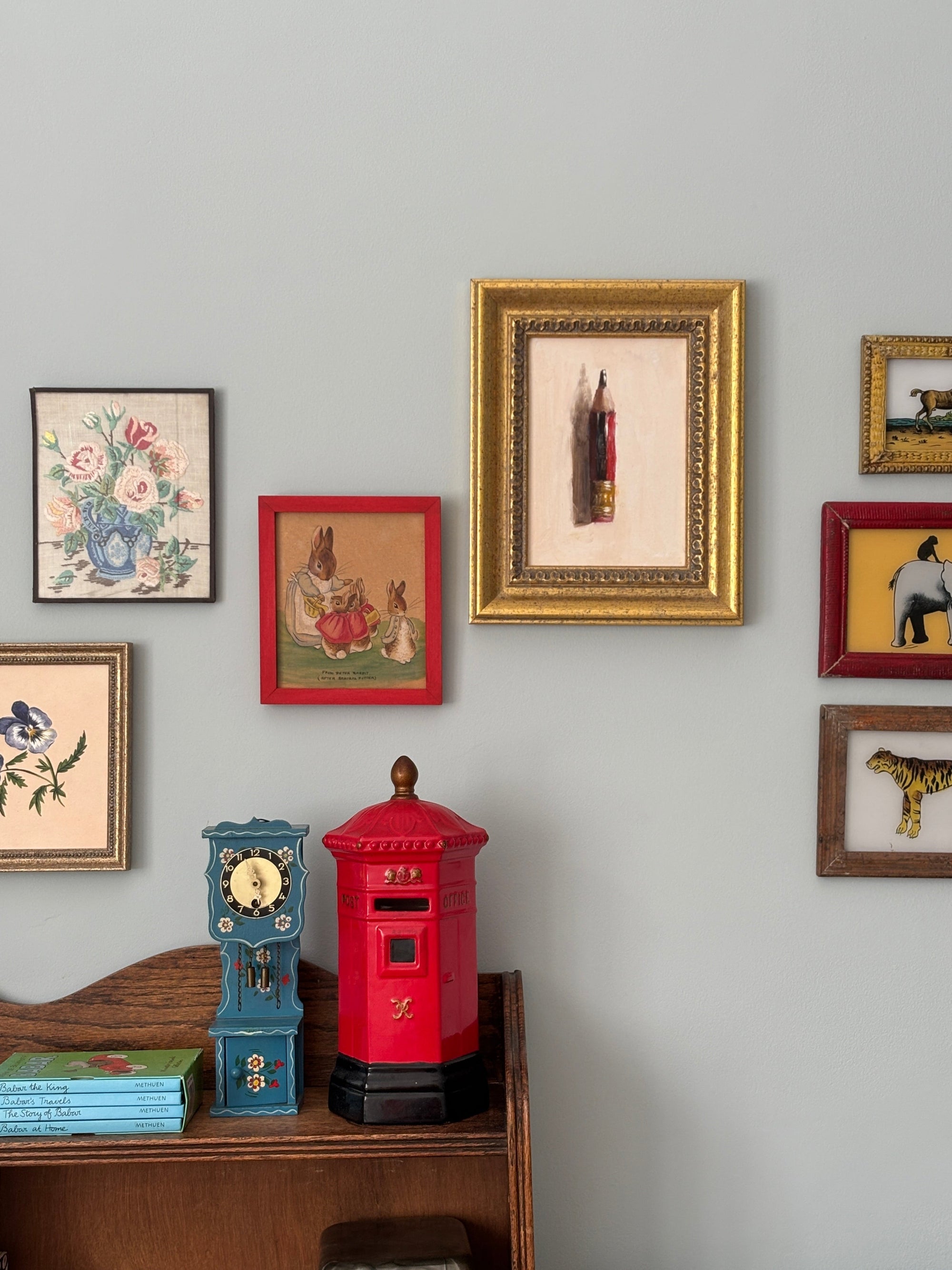SAFE, STYLISH WAYS TO INTRODUCE ART INTO YOUR CHILD’S BEDROOM OR PLAYROOM
From nurseries to playrooms to shared sibling bedrooms, original artwork can add depth, charm, and a sense of character that grows with your child. If you’ve ever hesitated to hang vintage or original art in a child’s space, here’s why we think it’s well worth doing, and how to do it beautifully.

https://homeinthehemlocks.com/
Why hang art in children's spaces?
Decorating a child’s room can be both fun and meaningful. While toys, books, and furniture are traditionally given careful attention, artwork can also play a special role. It offers more than just visual appeal, it shapes the emotional tone of a space and fosters creativity from a young age.
Add colour and charm
Original paintings provide a rich, tactile quality that prints and posters can’t always replicate. Whether hung over wallpaper, layered above a dresser, or paired over twin beds, original art adds warmth and sophistication, even in playful or whimsical settings. The texture, depth, and uniqueness of hand-painted works bring soul to a room, encouraging a feeling of home and comfort.
-
Create a sense of story
A vintage landscape, portrait, or still life introduces a narrative quality. These pieces often carry a sense of history and nostalgia, which can ground a room even when surrounded by the energy of childhood. Unlike mass-produced prints, vintage or original works feel personal, curated, and timeless. They are in essence creating a chapter in a story your child is growing into.
-
Art that grows with them
One of the best things about incorporating original or vintage artwork in a child’s room is its longevity. You’re not just buying wall décor, you’re choosing pieces that can move with them as they grow. The best art for children’s rooms isn’t necessarily themed around childhood. A gentle landscape, abstract shapes, or quiet still life can transition seamlessly from nursery to teenage bedroom and even beyond.

Placement Matters
When it comes to placing artwork in children’s spaces, safety and visibility go hand-in-hand. Artwork should be displayed in a way that complements the room’s layout but also keeps little ones from accidentally pulling or damaging it.

-
Hang It With Care
For valuable or delicate pieces, consider hanging them slightly higher, out of the reach of curious fingers, but still within visual reach. Use sturdy hooks or safety fittings designed to secure artwork properly. If you’re displaying a gallery wall, think about placing lighter, less fragile items at lower heights where children may interact with them safely.
-
Opt for Durable Materials
Oil paintings are a great option because they don’t require glass and are relatively hardy. Watercolour or paper-based pieces should ideally be framed with acrylic glazing (rather than glass) for safety. Canvas, wood panels, or fabric-based works also tend to withstand a bit more handling.
-
Mix Sizes and Styles
Don’t be afraid to mix large and small pieces for a more dynamic wall. A small painting above a nightstand can be just as impactful as a large canvas over the bed. The key is balance. Layer artworks in a way that feels organic and playful, just like the room itself.

Rethinking the Theme
-
It Doesn’t Have to Be “Childish”
Art in chillroom's rooms doesn’t have to scream “child.” In fact, the most timeless choices often don’t. A soft seascape, a botanical study or a bold abstract, these are all wonderful options that can help children develop a taste for art while still fitting beautifully into their daily environment. We adore botanical and floral artworks if the child is named after a flower. This can grow with them and wont feel outdated. Pressed flowers turned into art can also work beautifully.
Avoid limiting the space to cartoon characters or trends that may quickly feel outdated. Instead, choose works that are quietly interesting, joyful, or serene.
-
Use Art to Spark Creativity
Just as you might stock a child’s shelves with thoughtful books, displaying art introduces another layer of imagination into their lives. Looking at an intriguing painting daily might inspire a child to draw, paint, ask questions, or dream.
Even toddlers can form a connection to the art they see regularly. It becomes a visual backdrop to their early memories. Older children may even begin to develop their own artistic preferences and styles. You might find them gravitating toward certain colors or subjects, or asking to hang up their own creations.

Don’t Skip the Art
Whether you’re decorating a nursery, updating a toddler’s bedroom, or curating a space for siblings to share, don’t skip the art. It doesn’t have to be precious, just something that brings the room to life.
Start with one meaningful piece and build around it. Maybe it’s a painting that reminds you of your own childhood, or a landscape that brings peace.
Art tells a story and when placed in a child’s room, it becomes part of their story.
Do You Hang Art in Your Children’s Rooms?
We’d love to hear how you’ve styled it. What kinds of pieces do your childroom love? Have you created a gallery wall, collected vintage finds, or framed their own artwork? Please do share your photos, we’re always inspired by how creativity lives in the home.








